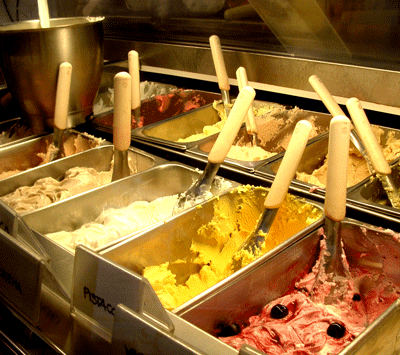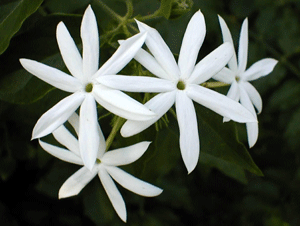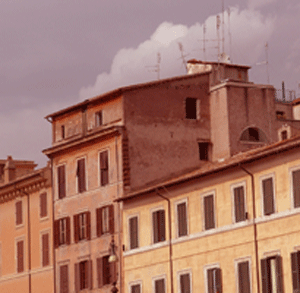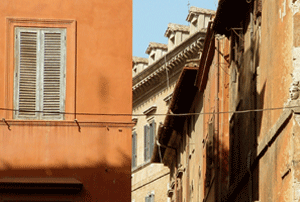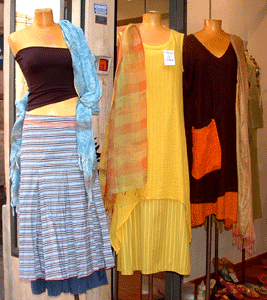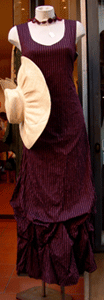|
|
|
The coffee here is a delight as well. From every bar and caffé whose doors open to the street comes a thick pungent aroma of strong dark coffee. No Nescafé
here, no muddy Turkish coffee that coats your teeth, no weak filtered stuff that takes like the beans were ground last year. This is the real thing, pure essence of
coffee in tiny cups that you taste, savoring the richness. It’s like the smell of jasmine, concentrated and intense.
The smell of jasmine is one of the delights of Egypt, Tunisia, and perhaps the rest of the Arab world. The blossoms don’t give a hint of the power of their
fragrance, small unimpressive white petals, drab green leaves. Nothing to look at – but when the breeze passes by and comes your way the perfume is enticing,
exciting, almost overwhelming. On the Cairo street, old women sell jasmine blossoms strung like a necklace or a rosary, that you play with in your fingers or wear
around your neck to encircle your senses with the fragrance. In Tunis they bind the flowers into bundles, thre dinars for a small one, five for an extravagant one
to impress your girl. The scent takes me out of where I am, to another place, it carries me off into its own world of enchantment. It can’t quite be part of the
everyday world, it’s too wild, and too captivating.
Rome isn’t much like Cairo, though. I’m staying in a wonderful neighborhood of old buildings and cobblestone streets, a block from the river and a short walk
from everything else. It’s delightful here, like Paris but much more so. I’m sure there are dreary new parts of Rome, but I haven’t found my way to them. I’m
surrounded by buildings of wonderful texture, facades in a dozen shares of tan and pink, ochre and burnt siena, cream and rusty brown, in a rich texture like
heavy vellum. Their ceilings are high, tall glass windows folding open above the streets, wooden shutters closing out the sun when the day gets too hot. On the
high floors the luckiest residents have balconies and rooftop gardens. Potted palms form the skyline, garlands of vines hang over the rails and reach to the
windows a floor below. I don’t know how people ilves around here. There’s a hundred bars and restaurants and gelaterias, but hardly any place to buy vegetables
or cheese or milk, and I haven’t seen a single bakery. Maybe they are offices in those buildings – in another continent old places like these would house architects
and planners and interior designers. The neighborhood seems far too exotic, too historic, too trendy for ordinary businesses, for insurance agents or appliance
importers, unions or computer repair shops. I’ve seen people going in and out, though, and they seem to live here. An elderly woman, a young man in shorts with
a dog on a leash. They’re not heading to work, they’re going home. So I suppose people do live in this fabulous place. |
|
The Romans are, according to my Lonely Planet guide, obsessed with fashion. August is the season for sales, so I’ve been in and out of a lot of shops. Most
out again, as soon as I go in. They may be having sales, but to my way of thinking the prices are still staggering. Anything under €20 seems very cheap – most
things cost far more. In one shop the shirts were all 30% off – but they still ran to thirty, forty, sixty euros. Most of the clothes seem strange to me. Lots of things
in fabrics that went out of style in 1971 – synthetics with uninteresting prints in flat colors, skimpy little shirts in dull green, or orange and pink, for prices that
simply can’t be believed. Even the used clothes are outrageous – a battered briefcase for €65, pre-worn t-shirts for €20.
I did go into one store with fascinating clothes. Things that were, well, different. Flamboyant, elegant. Heavy layered skirts that would swing nicely as you
walk. Linen dresses in lovely earth tones, in swooping, flowing designs. Long taffeta dresses with skirts gathered near the hem. Nothing I could imagine wearing
unless I drastically changed my style – but perhaps things I’d like to wear if I could become a fashionable female. |
